From One Peter Five
By Hilary White
Editor’s note: the following is the second part in a series (see part one here) from our friend Hilary White, originally published at her new site, Hilary White Sacred Art. We hope you’ll visit her there for more about her discoveries in the ancient traditions of Western and Byzantine sacred art as she transitions from making her living primarily as a news writer to one as a painter of sacred art.
“What is holiness, anyway?”
Last time we talked about the question, “How, exactly, do I ‘pursue holiness’? What does it mean?” Today we’re going to look at the second half of the question. What does holiness mean anyway? We could look it up on Wikipedia or even in a catechism, but it might not help.
You can’t know you want something – still less devote your life to getting it – until you know what it is.
We can point to the saints, and say we know them when we see them – particularly the kind with the spectacular gifts – but that doesn’t mean we know what precisely constitutes their sanctity. Or, most importantly, how to get there ourselves. Exactly, concretely, precisely and practically, how do you get from here to there?
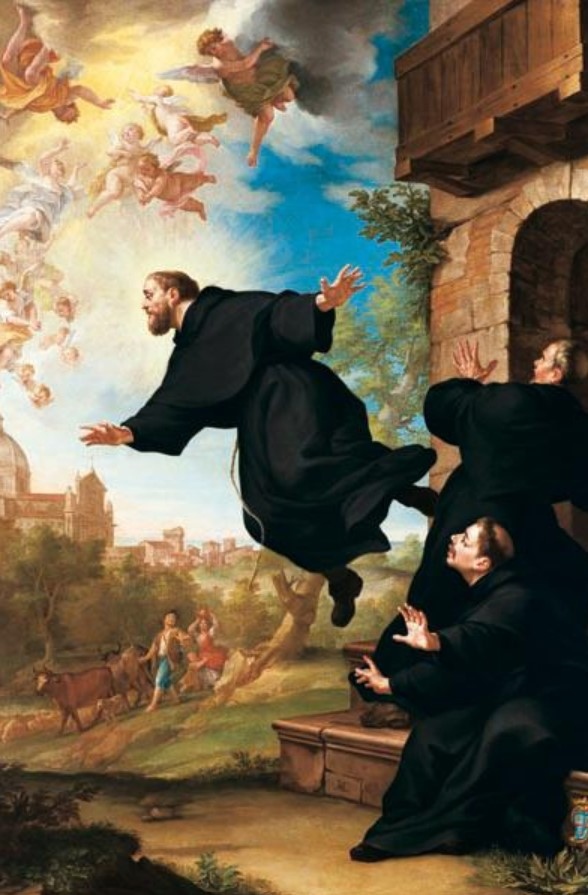
In fact, spectacular sanctity – the floating, bilocating, wonderworking kind – can often be for modern people a way of dismissing sanctification altogether, at least as a possibility for themselves. We assume not that we can emulate such people and follow their path to become saints ourselves, but that God has simply chosen some people, or made some people, as specially gifted and we’re not one of them. We excuse ourselves on about the same grounds as people do who dismiss the ability to draw as mere “talent”. They have the “gene” for sanctification and we do not.
So not only do we not aspire to it ourselves, we might even feel as though it is presumptuous to try. “That’s fine for St. Gerard Majella and Bl. Margaret of Castello to do all that healing and floating and whatnot, but I’m just a regular schmoe.” We turn back to the TV or the internet, rather relieved that it’s not really a matter of work and we’re off the hook for such grandiose expectations.
Such thinking was, by all accounts, common in religious life before the Asteroid, in which novices were positively discouraged from reading the spiritual works of their founders, like St. Teresa of Avila, for fear of them acquiring wild ideas for themselves.

It is something akin to the British working class fear that a child will “get above himself” if he is encouraged to read books too much – he will give himself unfulfillable dreams about his future prospects, when the only work available in town is in the factory or the mine. Encouraging such flights of fancy will sabotage his happiness. Best he gets no hint of higher things and keeps his feet firmly on the ground of this life.
But this attitude makes a fatal mistake: we are not, in fact, meant for this life at all, which is why the suggestion that we are is so depressing, so disappointing.
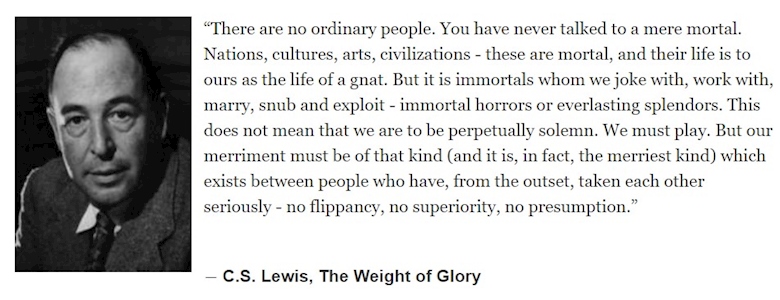
C.S. Lewis became famous for preaching the better, higher things to the grey and perpetually depressed English; “You have never met an ordinary human being,” he said in one of his radio theology sessions. We are all meant for the golden splendours of eternal bliss, so glorious that even the wonders of a gilded Baroque ceiling look poor and tawdry in comparison.
We must throw off the idea that the dull, grubby drudgery of this earthly life is what we are meant for. Think bigger. I will go so far as to say that it is one of the things for which we may thank the Second Vatican Council that it made the idea of the “universal call to holiness” respectable again – though it seems to have discouraged all possibility of actually fulfilling it in any practical sense.
Sanctification is simply living in heaven in this life.
There certainly seems to be an unbridgeable gulf between regular, lumpy old me, sitting down here on hum-drum, non-magical planet earth, and the dazzling wonders of the heavenly hosts.
But is this model really correct? It’s easy to assume so, if we spend our lives carefully avoiding the wonderful, tantalising – intimidating – alternative view: that this life is infused with heavenly wonders and glories. We see it in the saints most clearly and in their fantastic works, their transformed lives and their miracles, their unearthly wisdom, their utter fearlessness…
These traits – the thing we call “holiness” – are a result of the dual citizenship of the saints who travelled frequently, daily, hourly, all throughout their earthly lives between heaven and earth, bringing a little of the former into the latter every day. For the saints, the earthly life is already heavenly, and not merely “despite” the suffering that always comes, but because of it, or more properly, because of their grace-filled response to that suffering.
It is something I suspected from childhood – that wonderful, magical realities were hiding just barely out of sight, behind every leaf and blade of grass. We might not ever admit it to any of our sensible, down-to-earth, business-as-usual friends or family, but don’t we suspect that there is something more to the world than we’re told? It’s like a belief that many people secretly hold in the existence of fairies – an entirely wonderful, otherworldly reality lives right here with us, if only we could learn the knack of seeing it.
Is this perhaps the underlying origin of our love of nature, our fascination with birds and plants and animals? Of awe-inspiring weather, or extraordinary intricacies we can see in tiny life forms under an electron microscope? Why do we climb mountains just to look at the view? Why do we not dismiss as merely earthly events – all perfectly explainable and natural – phenomena like the Aurora Borealis, or the recently discovered lightning “sprites”. Why do we stand thrilled in awe and joy and wonder at something so common as a thunderstorm?
There is something inherent in the human makeup that thrills at these things; we are built with a capacity for awe. We have a built-in numinous sense. And we have to work very hard at deforming that nature to suppress it – which is what the World has accomplished so well in the last 250 years. All children know the thrill of joy at seeing a wild animal, hearing thunder far off or gazing deep into the heart of a tiny wildflower, looking for its great, cosmic meaning.
Icons: the lenses of the numinous
One day you wake up very early, as the sky is only beginning to lighten. You’re sure you heard a knock on the door of your little city flat. You get up and wrap your bleary self in your housecoat and peek through the spy hole and see a man standing in the hall, dressed like a postman, with a bag over one shoulder bulging with brown paper wrapped packages. He smiles and waves at you through the peek hole.
He looks harmless enough so you open the door, and he holds out a small package. You are still sleepy enough to fail to be cautious and you reach out to take it. The man gives a small wink and disappears, leaving you holding the little paper-wrapped box, wondering if you’d really seen what you just saw.
The package is completely plain, only wrapped in a bit of white string, except for a single symbol, stamped in what looks like gold:
After a coffee to settle your brain, with the package sitting on the kitchen counter, you dare to shake it. Just a dull little thump indicates there is something inside. No scrabbling or squeaking; at least it’s not alive.
You decide to take the risk and it’s just a pair of glasses.
There’s a note, written in beautiful cursive with a fountain pen: “What you’re looking for is right here.”
There’s only one thing to do.
There’s a good reason modern people are wild about fantastic tales of wizards and superheroes. We all know, don’t we, that there’s more to life than this dull, pallid, mechanical existence we’ve made for ourselves. That we’ve trapped ourselves in.
It’s what I’ve discovered in the world of iconography and sacred art – all of which is (or is supposed to be) an expression of the existence of this higher reality as it lives right down here with us. Heaven comes to us through the “door” of the icon, and the paintings (and the architecture) provide a door for that higher reality to enter our world. I’ve looked for the Door to Narnia all my life, and here it is; it might be a while before I can go through it, but it can allow heaven to visit me, I can befriend the heavenly hosts. I can become a Narnian citizen, though for now an expat, and look through it to my home every day.
Aidan Hart, the English iconographer, wrote about it in a small instruction manual for gilding icons. What is the symbolism of gold on an icon? It is not mere decoration. It represents the Divine Order of the universe, that which created it and sustains it from moment to moment. The halo and gold accents in an icon of a saint or angel represents the glory of God shining out from within.
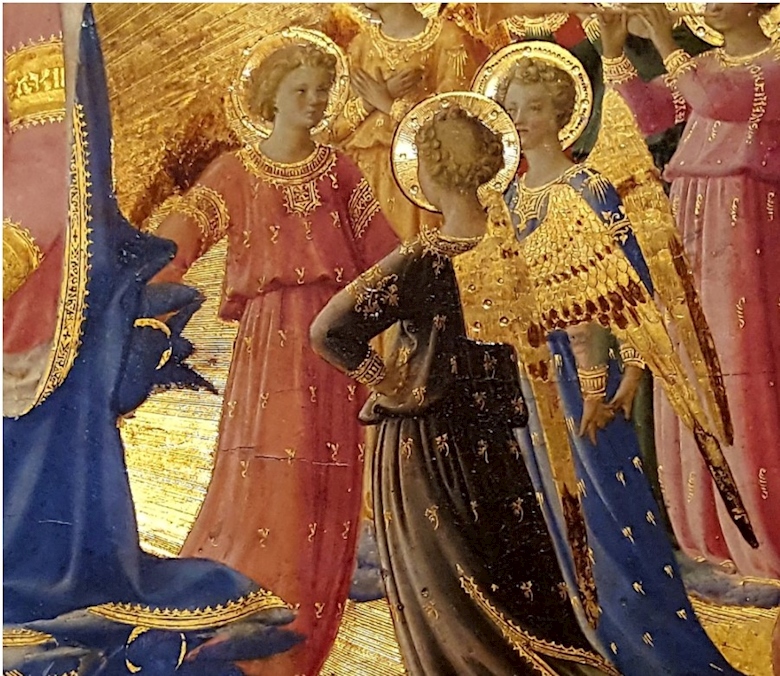 Fra Angelico. For more pics, visit Becky Dimattia’s photo blog
Fra Angelico. For more pics, visit Becky Dimattia’s photo blog
Gold has been used in religious and votive objects since ancient times for essentially this purpose not only because of its colour, but because it is imperishable – it never tarnishes or fades and is impervious to sunlight or age, all divine attributes recognised as such by ancient peoples.
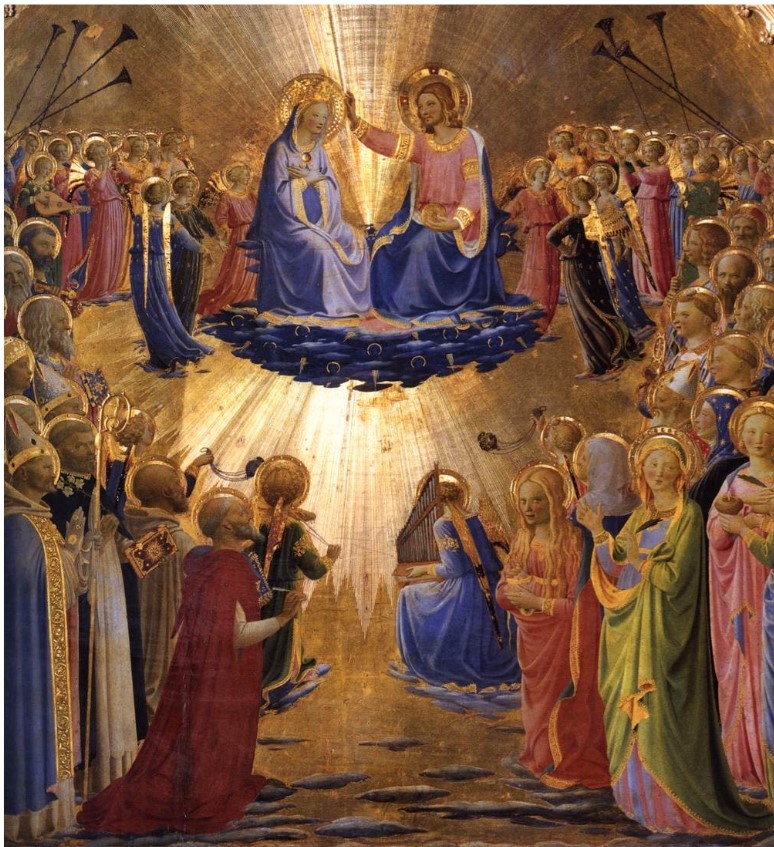
In Orthodox icons, as in sacred arts of many other religions, gold symbolizes divine presence, glory, spiritual light. Gold is not a colour as such, as are the other elements of the icon; it is of a different order of existence. That is, it represents the divine order, which creates and sustains the created order.
As background the gold shows that it is in God that we “live and move and have our being”, as Saint Paul said. God is like the water within which all creation swims like fish in the ocean.
The gold halo represents the Holy Spirit’s indwelling of the saint, the ‘shekinah’ [Hebrew for the manifestation of the presence of God] glory of God shining from within.
The little red flame on the angel’s head is the fire of the Holy Ghost. Fra Angelico
The gold in the background represents the “water” of the ultimate reality of God in which we are all swimming, and the halos represent that same Divine glory coming forth from the saint. On the clothing in lines and accents, it “represents the material world being transfigured by God.”
The lines thus do not denote superficial decoration, but rather an inner, transforming presence of the Divine within the inimate world. These lines follow the basic form of the object on which they are drawn – the drapery, tree trunk or whatever – but are abstracted enough to show that they represent a spiritual reality and do not just suggest form.
And it is this higher reality, living right here with us in the world, that Christian mysticism seeks to gain access to. This is the transforming power of the sacramental life, but we must learn to enter it.
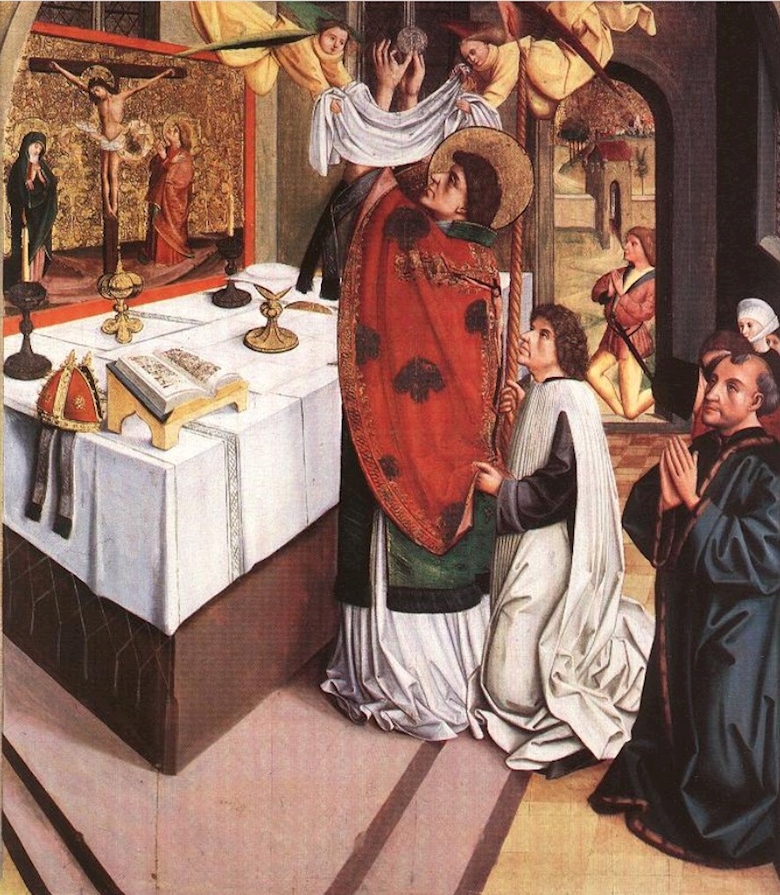
The Sermon of St. Martin, artist unknown. c. 1490
Why aren’t the Sacraments fixing me?
It is a mistake to think that the theological expression “ex opere operato” works on us as well as it does on the bread and wine. Transubstantiation happens but the Most Holy and August Sacrament of the Altar isn’t a magic pill. Catholics have acquired a distorted understanding in our time of how sacramental grace works. We imagine that it’s an automatic thing – we receive Communion and are made saints… some day. But ask yourself; has that day come? Are you being changed? If you are not being transformed as you hoped, what more can you do? What’s missing?
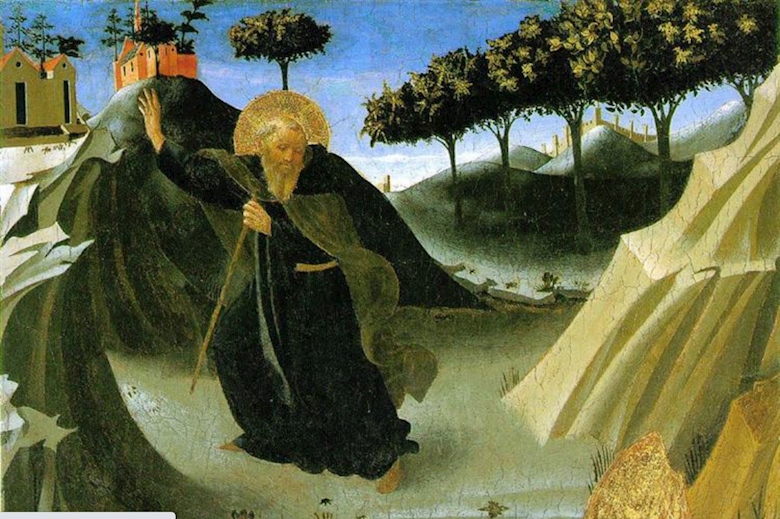 First, flee temptations. St. Anthony flees from the demonic mass of gold in the desert.
First, flee temptations. St. Anthony flees from the demonic mass of gold in the desert.
Fra Angelico
And this is the catch to the whole business, the thing we’re missing since the 1960s and the Church went silent on her mystical tradition. You have to be prepared. You have to do the work. God won’t meet you “half way” – because half way through an infinite distance is still infinite – He’s going to be right in front of you, right behind you. But He does want you to do at least a little work, take a few steps forward. You need to struggle against the inertia and spiritual obstacles, at least a bit.
In short, while the Eucharist is Christ, even He cannot change you until you are ready to be changed. This is the old fashioned notion of “dispositions”. We modern Catholics are still (mostly) aware that we must be in a state of grace – that is, not have unconfessed mortal sin – to receive Communion lawfully, but this is the very rock bottom minimum requirement. This is what it takes only to live your life teetering one inch from the edge of the cliff of calamity.
To get from this life lived constantly on the edge of barely doing enough to actual holiness there is stuff you need to do.
And that’s where prayer comes in.
Stay tuned for Part III.
Homework assignment — Google search the following terms:
- transforming union
- purgative way
- Mental prayer
- Lectio Divina
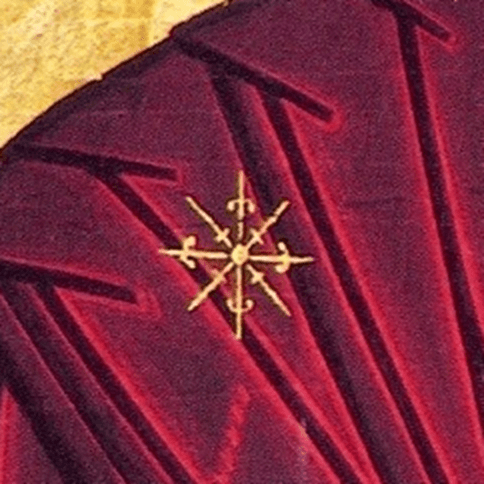

No comments:
Post a Comment
Comments are subject to deletion if they are not germane. I have no problem with a bit of colourful language, but blasphemy or depraved profanity will not be allowed. Attacks on the Catholic Faith will not be tolerated. Comments will be deleted that are republican (Yanks! Note the lower case 'r'!), attacks on the legitimacy of Pope Francis as the Vicar of Christ (I know he's a material heretic and a Protector of Perverts, and I definitely want him gone yesterday! However, he is Pope, and I pray for him every day.), the legitimacy of the House of Windsor or of the claims of the Elder Line of the House of France, or attacks on the legitimacy of any of the currently ruling Houses of Europe.